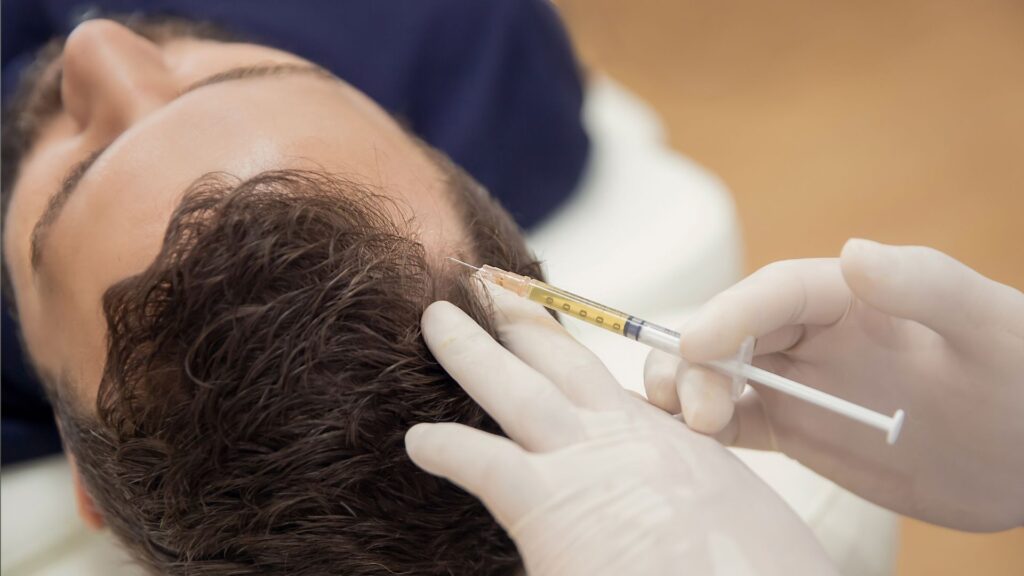
- 1, Navjeevan Vihar, Geetanjali Enclave, Malviya Nagar, Delhi 110017
- +91 8448073101
Follow us

Imagine waking up one morning, looking in the mirror, and noticing that your hair is thinning. For many, this is a reality that can be distressing and impact self-esteem. Hair loss is a common issue affecting millions worldwide, and while there are numerous treatments available, one that has gained significant attention is Platelet-Rich Plasma (PRP) therapy. But does PRP really work for hair loss, and is it safe? In this article, we’ll delve into the science behind PRP, explore its effectiveness, and discuss safety concerns to help you make an informed decision.
PRP therapy involves using a concentration of platelets from your own blood to promote healing and regeneration in various parts of the body. Originally used in sports medicine and orthopedics, PRP has found its way into the world of dermatology and hair restoration.
Blood Collection: A small amount of your blood is drawn, similar to a routine blood test.
Centrifugation: The blood is placed in a centrifuge, which spins it at high speed to separate the platelets from other blood components.
Injection: The concentrated platelets are injected into the scalp at the level of the hair follicles.
The theory is that the growth factors in the platelets can stimulate hair follicles, encouraging hair growth and improving hair thickness.
Research on PRP for hair loss is still in its early stages, but several studies have shown promising results. For instance, a study published in the Journal of Cutaneous and Aesthetic Surgery found that patients receiving PRP injections experienced significant hair regrowth compared to those who did not.
Many individuals have reported positive outcomes with PRP therapy. For example, Sarah, a 35-year-old marketing executive, noticed a visible improvement in her hair density after just a few sessions. “I was skeptical at first,” she admits, “but seeing the results firsthand was truly encouraging.”
Individual Variation: Not everyone responds to PRP in the same way. Factors such as age, the extent of hair loss, and overall health can influence results.
Consistency: Regular sessions are often necessary to maintain results, with many practitioners recommending treatments every 4-6 weeks initially.
PRP is generally considered safe since it uses the patient’s own blood, minimizing the risk of allergic reactions. However, some common side effects include:
Mild pain or discomfort at the injection site.
Temporary swelling or redness.
Minor bruising.
Though rare, some individuals may experience:
Infection at the injection site.
Injury to blood vessels or nerves.
Scar tissue formation.
Before undergoing PRP therapy, it’s crucial to consult with a qualified healthcare provider to assess your suitability for the treatment. Individuals with certain medical conditions, such as blood disorders or active infections, may not be ideal candidates for PRP.
PRP therapy for hair loss offers a promising option for those seeking to improve hair density and thickness. While clinical studies and personal anecdotes suggest positive outcomes, it’s essential to approach this treatment with realistic expectations and an understanding of potential risks. If you’re considering PRP, consult with a healthcare professional to determine if it’s the right choice for you.Ultimately, the decision to pursue PRP should be based on a thorough evaluation of its benefits and limitations. As with any medical treatment, informed consent and professional guidance are key to achieving the best possible results.
We’re here to help with expert answers and personalized support.”

The SCM Clinic’s promise to transform lives by restoring health and boosting confidence, empowering you to look and feel your best.
+91 8448073101

The SCM Clinic’s promise to transform lives by restoring health and boosting confidence, empowering you to look and feel your best.
+91 8448073101